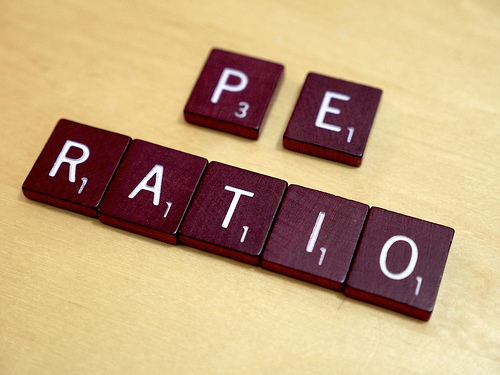
Reading about JP Morgan and trying to think about its tangible book value was a murky old business, and it made me think that it might be worthwhile to go back to the beginning and revise what I know about the basics of investing, before returning to the JPM annual report better prepared. The P/E ratio (price/earnings) is the first place to look when trying to decide whether a prospective purchase price would represent good value or not.
£75 a share? Crikey, that sounds expensive
… well, not necessarily. When you buy a share, what you are actually buying is the right to a share of the company’s future earnings stream. The £75 by itself tells you nothing about whether the share price is expensive or cheap; you also need to know how much the company earns for each share (i.e. its EPS or earnings per share). Once you know this, you can calculate the earnings multiple you would be paying when you buy a share–i.e. its P/E ratio or, for short, the multiple. For example:
- ITV sells for 181p and last year earned 11.2p for each share. This gives it a P/E ratio of 16 (181/11.2).
- British Sky Broadcasting Group sells for 874p and last year earned 60p per share. BSkyB’s P/E ratio is, therefore, 14.5.
- Admiral Group sells for 1392p and last year earned 104.6p. Admiral’s P/E ratio is 13.3.
So, in terms of P/E ratios rather than nominal share prices, Admiral is the cheapest and ITV the most expensive. Why does ITV have a higher P/E ratio? The usual answer is that the market expects ITV to grow its earnings faster and so asks investors to pay more for its better prospects. Deciding whether the market is right or wrong in this assumption is the essence of the Great Game that is investment: paying as little as possible today for as much as possible tomorrow. Despite a high P/E ratio, it will still be worth investing in a company if it grows its earnings sufficiently to justify the high multiple.
How do you use it?
The P/E ratio is not a crystal ball that tells you how quickly a company’s earnings are going to grow, it just tells you the multiple that you will be paying for the last year’s earnings. However, if they are selling for more than the market or industry average, then you can at least infer that the market expects the company’s earnings to grow faster than the average market or industry earnings. Whether or not you agree with the market’s opinion will determine whether you make the purchase.
While it would not make sense to buy Company A in preference to Company B simply because it has a lower P/E Ratio, it can give you a starting point for your share selection. Why is Company A’s multiple lower? Are its prospects that much worse? Is its sector facing headwinds? If the companies operate in the same sector, then what differentiates them? Management, patent expiries, labour problems, financial stress? Is the lower multiple justified? How does a company’s P/E ratio today compare with its historical P/E ratio, and are its prospects today worse or is the market just in a generally downbeat mood?
A P/E ratio can also be calculated for the broader market or industry sectors and this can be a useful way to take a quick temperature check of the general mood. If you had done this at the time of the Dot Com nonsense in 1999 or the Financial Love-In in the middle 2000s, then you might have battened down your hatches accordingly. Here is a link to the historical P/E ratios for the S&P 500. Remember that a spike in a P/E ratio can be caused by a collapse in earnings as well as a higher price–this is sadly obvious for the P/E in 2009.
Benchmarks
There are a couple of useful benchmarks that are worth remembering when looking at a P/E ratio:
- The P/E ratio that was considered appropriate by Ben Graham (considered the Father of Value Investing) for a company with no growth prospects was 8.5.
- According to Jeremy Siegel, in his seminal Stocks for the Long Run, the median P/E ratio for S&P 500 stocks, based on their last twelve months of earnings, is 14.50. The median P/E ratio based on the next twelve months of earnings–the forward P/E ratio–is 15.09. And so you could consider 15 to be a normal P/E ratio for an American company. If you are paying more, you should ensure that it is for a better than average company, otherwise you are likely to get below average results.The stock market, like everything, is subject to fads and P/E ratio can be a useful means to identifying these. For example, IBM, the bluest of blue chips, is currently selling at a P/E ratio of 12.7, while Facebook is currently selling at a P/E ratio of 81! The 81 does not leave a lot of room for disappointment in earnings growth, whereas the IBM multiple does. I will be hoping that the market is getting this one wrong.
Disclosure: Long IBM.
Disclaimer: This post is not a recommendation to either buy or sell. Please consult your investment advisor.
